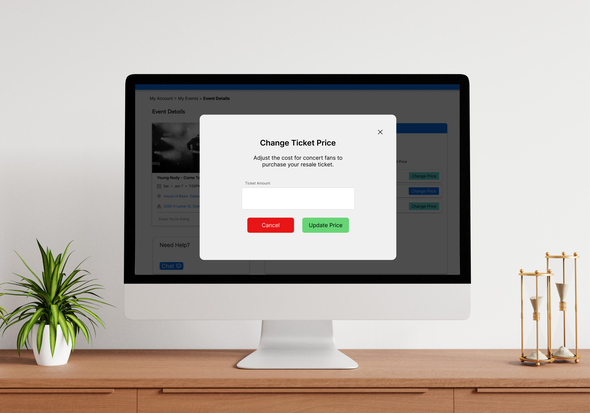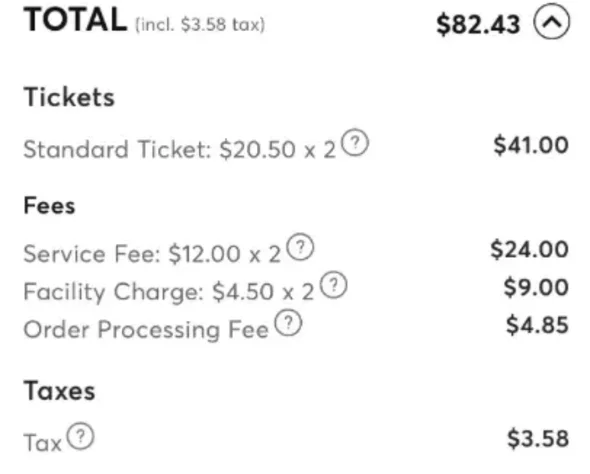.png)
.png)
With a high-profile antitrust lawsuit targeting Live Nation Entertainment and Ticketmaster, there is increasing pressure for greater transparency, ethical pricing, and improved consumer trust within the ticketing industry. In this speculative UX redesign, we focused on revamping Ticketmaster’s Seller Portal to proactively meet the demands of potential Department of Justice (DOJ) regulations. Our goal was to create a system that balances fair profit for resellers with buyer protection—ensuring compliance, trust, and usability across the resale experience. To ground our design in real needs, we conducted user interviews and journey mapping to uncover pain points around unpredictable fees, unclear resale pricing, and poor user experience for both buyers and sellers.
Our research revealed that ticket buyers often feel deceived by hidden costs and inflated resale prices, while resellers struggle with finding ethical ways to price tickets competitively without alienating true fans. Using these insights, we redesigned the Seller Portal with key features such as transparent pricing breakdowns, resale price caps, and fraud protection protocols. These changes aim to rebuild user trust and reduce friction in the resale process. Ultimately, success was defined by improved user satisfaction, reduced confusion around pricing, and a more balanced, trustworthy marketplace that benefits both sellers and buyers alike.



The live event ticket resale market is riddled with frustration, confusion, and distrust—especially on major platforms like Ticketmaster. As antitrust scrutiny and public backlash continue to mount against Live Nation and Ticketmaster, users are increasingly vocal about their negative experiences. For buyers, hidden fees, unclear pricing structures, and unethical resale markups create a sense of being taken advantage of. For sellers, the platform offers little support or guidance on ethical pricing strategies, creating a disjointed and uncertain resale process.
Our team conducted user interviews and surveys to better understand the real pain points experienced by both sides of the resale exchange. A recurring theme was a deep-rooted lack of transparency. As one user put it:
“Buying from venue or Ticketmaster already gives an ick because of fees on the backend that don’t make sense.”
— Actual user, Karla J.
Many users also reported feeling unsure whether they could trust listings, fearing scams, bots, or excessive markup by opportunistic resellers. For sellers, the challenge lies in finding a fair price that honors the value of the ticket while also appealing to true fans. This lack of clarity and trust negatively affects resale completion rates and damages brand reputation. Ultimately, users want more than just a transactional experience—they want fairness, safety, and transparency embedded into the resale process.
Our hypothesis was simple: by implementing transparent pricing breakdowns, setting ethical price caps, and introducing fraud prevention measures, we could create a resale experience that is not only smoother but more trustworthy and ethically sound. Our goal was to redesign the Seller Portal in a way that empowers both buyers and resellers, ensuring a platform that prioritizes real fans over profits, and transparency over exploitation. We’ll measure success through increased user satisfaction, reduced complaints, and higher completion rates across resales.

To address the ethical and functional concerns raised by users, our team redesigned Ticketmaster’s Seller Portal with a focus on transparency, trust, and fairness. Grounded in our research, we prioritized the needs of both resellers and buyers by creating a system that clarifies pricing, establishes guidelines for fair resale, and minimizes the risk of fraud. The design direction aimed to strike a balance between user empowerment and regulatory alignment—ensuring Ticketmaster could adapt to potential Department of Justice regulations while also rebuilding user trust.
Key features of the redesign include transparent pricing breakdowns that show both buyers and sellers exactly where their money goes—from the base ticket cost to service fees and resale adjustments. We also introduced ethical pricing caps to prevent excessive markups while still allowing resellers to earn a fair return. To address concerns around fraudulent listings, the portal includes ticket verification and documentation, helping ensure that all resale tickets are authentic and traceable. These tools work together to create a resale experience that feels secure, ethical, and simple to use.
In addition to structural improvements, we also focused on educating the user within the platform. A contextual pricing guide and dynamic feedback during listing creation help sellers make informed decisions without resorting to guesswork. For buyers, visual trust signals such as verified seller badges and real-time fee previews help eliminate surprises and restore confidence. Together, these design choices aim to reduce user frustration, improve resale outcomes, and establish Ticketmaster as a platform committed to fairness, transparency, and ethical practice.
In light of the U.S. Department of Justice’s antitrust lawsuit against Live Nation and Ticketmaster, our team led a speculative redesign of Ticketmaster’s reseller portal. The goal: create a more transparent, compliant, and user-friendly experience that aligns with potential legal requirements and restores user trust in the resale process.
We began by understanding user pain points through interviews and surveys. Participants described resale platforms as confusing, fee-heavy, and error-prone. Key frustrations included:
These insights became the foundation for our problem definition and design direction.
From our research, we identified a core challenge:
“Users need a resale experience that builds trust through transparency, prevents errors, and offers reassurance at critical moments.”
We built user personas and journey maps to visualize touchpoints where trust and usability broke down. This helped us prioritize improvements for listing, transferring, and editing resale tickets.
We created low-fidelity wireframes inspired by Ticketmaster’s current UI to align with users’ mental models. Design decisions included:
These wireframes prioritized ethical design principles and error prevention.
To validate our direction, we tested the prototype with users completing three core tasks:
All users successfully completed their tasks. However, feedback highlighted a need for stronger confirmation checkpoints—especially for irreversible actions like transfers.
We then created high-fidelity mockups using Ticketmaster’s official brand guidelines—applying consistent colors, typography, and interface patterns.
Key improvements included:
The final prototype balanced visual polish with functionality, ensuring alignment with both user expectations and legal compliance standards.